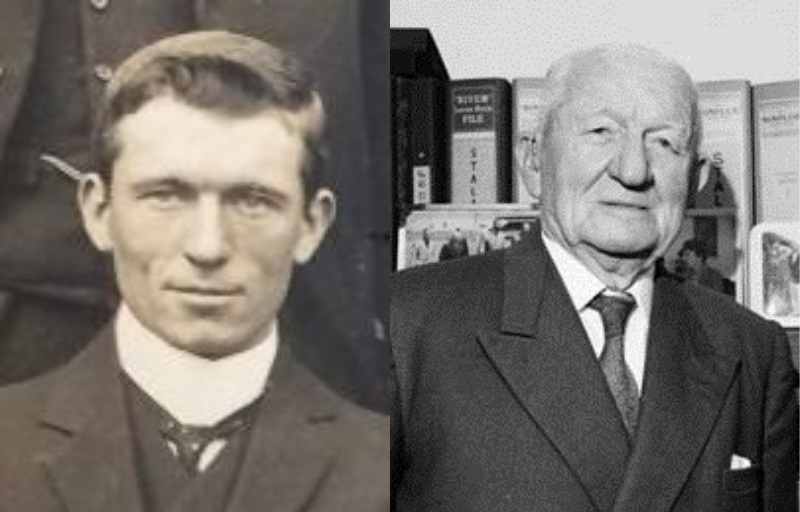Sydney Smith OBE 1880-1972
Randwick Petersham Cricket Club | October 10, 2024

The most influential man in the NSW Cricket Association between the two World Wars was Sydney Smith. By the time he turned 40 in 1920 he had held every senior post in the Association except the role of President which he was later to hold for 30 years.
Born in 1880, Sydney Smith Junior had an early interest in cricket and its administration. In his teens he was secretary of a junior club at Annandale before moving to Bathurst where he was secretary of his school’s cricket club for three years. He later took on a similar role with the Hawkesbury Agricultural College.
He joined the Petersham club in 1901-02 and immediately assumed the role of Hon Secretary, holding the position for 15 years. When Smith joined it was a 2nd Grade club not being admitted to 1st Grade until 1907-08. It seems that such elevation was achieved largely through the efforts of the energetic and enterprising young Syd.
Despite his club commitments, Smith quickly became involved with administration at State and National level. He was Hon Secretary of the Australian Board of Control for International Cricket in the formative years 1911 to 1926 and Hon Treasurer between 1911 and 1922. He managed the highly successful Australian tour of England and South Africa in 1921 and the tour of England in 1926. He also represented Australia at the Imperial Cricket Conference.
Australian Tour of England and South Africa 1921
Back: Sydney Smith Jnr (Manager); Jack Ryder, Jack Gregory, Hunter Hendry, Ted McDonald, Arthur Mailey
Middle: Warren Bardsley, Charlie Macartney, Warwick Armstrong (captain); Herbie Collins, Hanson Carter
Front: Johnny Taylor, Tommy Andrews
In 1912, Smith was involved in one of the most famous and controversial incidents in the history of Australian Cricket. Appointed Hon Secretary of the Board of Control shortly before, he was present during a selection meeting in the Elizabeth Street, Sydney Office of the NSW Cricket Association prior to the Third Test in Adelaide against Johnny Douglas’ touring English team. It was one Test apiece after the first two matches and the three-man selection committee of Peter McAlister, Frank Iredale and the Australian captain Clem Hill were keen to ensure their best team was on the field. However, there was disagreement between McAlister and Hill on the merit of including Charlie Macartney, who Hill wanted in the team.
During what was a heated debate, McAlister claimed Hill “was the worst captain I have ever seen”. Hill then warned his co-selector not to repeat the comments but when he did, Hill leaned across the table and slapped him across the face with an open hand. McAlister rose from his chair, rushed around to where Hill was then standing and, according to the official report on the incident by Smith, “a fight ensued with both selectors grappling and trying to punch each other in the small space between the table and the wall.”
Smith further reported that he eventually managed to separate the two combatants as Mr Ireland was powerless to act having been jammed into a corner by the table which slewed around when the scuffle first broke out. But despite this action, the two came together again with furniture being “knocked all over the place and pictures broken.” At one point there was a chance they could both fall out of the second floor window onto Elizabeth Street as they wrestled onto the window sill. However, this was prevented by Iredale reaching across and grabbing McAlister by the arm while Smith “pulled Hill off by the coat tails.”
While McAlister was covered in blood after the altercation, Hill “bore no marks” but resigned as a selector later that evening. The Third Test team was later picked by McAlister and Iredale. Clem Hill remained as captain for the three remaining Tests, which were all lost.
In 1916 Smith transferred to the Gordon club where he took over as Hon Secretary for the next six years. With his 15 years at Petersham his total of 21 years as a Grade club secretary was a new record. The year after his move to Gordon he was made a Life Member of the Petersham club.
A member of the NSW Cricket Association executive from 1907, Smith was President of the Association from 1935 to 1966, during which years NSW won the Sheffield Shield 16 times in 25 years. He was a Life Member of the Association and made an Honorary Life Member of the Australian Board of Cricket Control. He was also President of the Cricketers' Club of NSW, a trustee of the Sydney Cricket Ground and as a career NSW public servant, he was President of the NSW Public Service Cricket Association. In 1937 he was awarded an OBE and in 1956 was made a Commander of the British Empire.
A tee-totaller and non-smoker, Smith was a good mixer and highly efficient organizer. He revered Victor Trumper as the greatest batsman he had seen and regarded the atmosphere generated by a Sydney crowd at a Test match as unmatched anywhere in the world.
As a player, Smith never progressed beyond 2nd Grade but held the Petersham highest score record for that grade for 26 years. In 1901-02 he scored 187 against Leichhardt which was the club record until Dermott McDermott hit 205 against Paddington in 1926-27. As a leg-break bowler, he took the Petersham bowling honours in that grade in 1914-15 with 54 wickets at 13.66 and again the following season with 46 at 15.63 runs each.
When he moved to Gordon, he continued to play lower grades until he was 46 years of age. When he retired, he did so with a total of 3,709 runs and 535 wickets in all Grade matches.
Smith stepped down as NSW Cricket Association President in 1966 aged 86. He had been involved in cricket administration for almost 70 years, all for no financial reward. He died on 11 April 1972 at Chatswood aged 92. The present Sydney Cricket Association Club Championship trophy is named in his honour.
RPC Hon Historian








